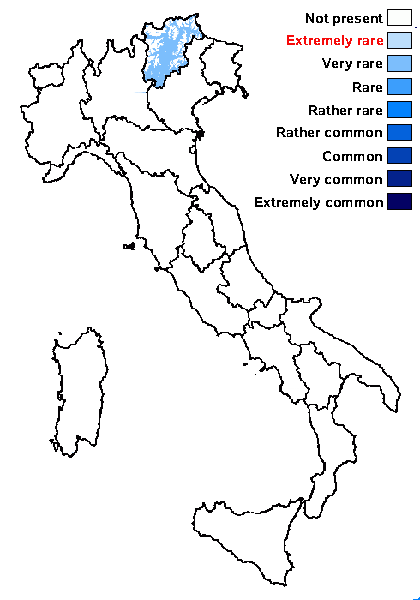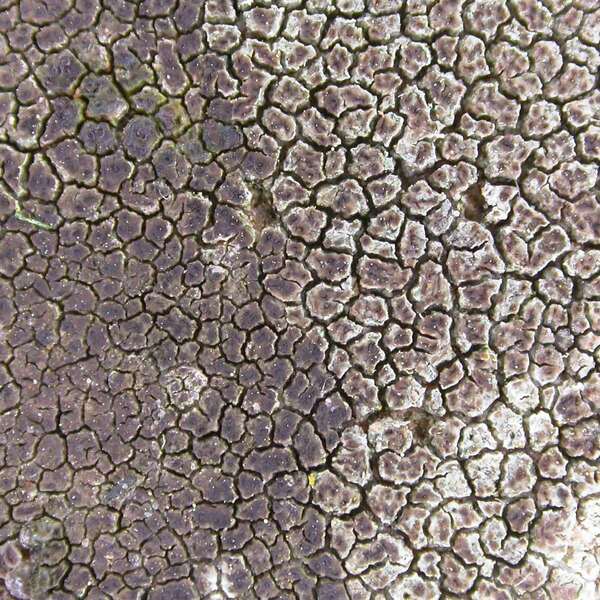Myriospora rufescens (Turner ex Ach.) Hepp ex Uloth
Flora, 44: 618, 1861. Basionym: Sagedia rufescens Ach. - Lich. Univ.: 329, 1810
Synonyms: Acarospora rufescens (Turner ex Ach.) Kremp.; Acarospora smaragdula (Wahlenb.) A. Massal. var. rufescens (Turner ex Ach.) Clauzade & Cl. Roux; Lecanora rufescens (Turner ex Ach.) Nyl.; Silobia rufescens (Turner ex Ach.) M. Westb. & Wedin; Trimmatothelopsis rufescens (Turner ex Ach.) Cl. Roux & Nav.-Ros.
Distribution: N - TAA (Dalla Torre & Sarnthein 1902).
Description: Thallus crustose, episubstratic, areolate, forming an extensive, smooth, even crust, dull to dark brown, becoming thinner towards the edge, the areoles contiguous, separated by cracks, angular, (0.3-)0.4-1(-1.5) mm wide, 0.2-0.4 mm thick, flat to concave. Epicortex absent or very thin; cortex 30-40 µm thick, the cells mostly c. 2 µm wide, brown in upper part, colourless in lower part; algal layer 80-100 µm thick, irregularly interrupted by 10-15 µm wide hyphal bundles; medulla 100-250 µm thick, continuous with attaching hyphae, mixed with substrate crystals. Apothecia 0.2-0.4 mm across, 1-2 per areole, immersed, with a black (brown when wet), deeply concave disc concolorous with or darker than thallus, and an entire, slightly raised, black prominent margin. Proper exciple 25-40 µm wide, colourless, but the uppermost cells with dark brown caps; epithecium 10-15 µm high, brown to dark red-brown; hymenium colourless, (60-)80-120(-140) µm high, the hymenial gel hemiamyloid, IKI+ red or blue turning to red; paraphyses simple to sparingly branched and anastomosing 1-1.5 μm thick, the apical cells hardly swollen, cylindrical to clavate; subhymenium 10-30 µm high, opaque, densely inspersed with oil droplets, IKI+ blue; hypothecium 20-35 µm high, IKI-. Asci 100-200-spored, clavate, the apical dome K/I-, 80-100 x 10-20 µm. Ascospores 1-celled, hyaline, ellipsoid, 3-4 x 1-1.5 μm. Photobiont chlorococcoid. Spot tests: cortex and medulla K-, C-, KC-, P-, UV-. Chemistry: without lichen substances. Note: apparently a mainly western species, found on sandstone and other siliceous substrata, chiefly on monuments, gravestones, and wall tops, reported from a few localities in the Alps. The several records from TAA in Dalla Torre & Sarnthein (1902) appear as dubious to me.
Growth form: Crustose
Substrata: rocks
Photobiont: green algae other than Trentepohlia
Reproductive strategy: mainly sexual
Commonnes-rarity: (info)
Alpine belt: absent
Subalpine belt: extremely rare
Oromediterranean belt: absent
Montane belt: very rare
Submediterranean belt: very rare
Padanian area: absent
Humid submediterranean belt: absent
Humid mediterranean belt: absent
Dry mediterranean belt: absent

Predictive model
Growth form: Crustose
Substrata: rocks
Photobiont: green algae other than Trentepohlia
Reproductive strategy: mainly sexual
Commonnes-rarity: (info)
Alpine belt: absent
Subalpine belt: extremely rare
Oromediterranean belt: absent
Montane belt: very rare
Submediterranean belt: very rare
Padanian area: absent
Humid submediterranean belt: absent
Humid mediterranean belt: absent
Dry mediterranean belt: absent

Predictive model
 INDEX FUNGORUM
INDEX FUNGORUM
 GBIF
GBIF
 DOLICHENS
DOLICHENS


